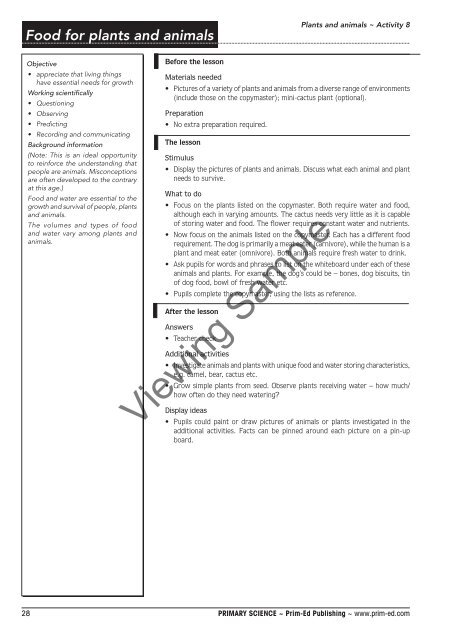PR-0552UK Primary Science - Book 2
Create successful ePaper yourself
Turn your PDF publications into a flip-book with our unique Google optimized e-Paper software.
Food for plants and animals<br />
Plants and animals ~ Activity 8<br />
Objective<br />
• appreciate that living things<br />
have essential needs for growth<br />
Working scientifically<br />
• Questioning<br />
• Observing<br />
• Predicting<br />
• Recording and communicating<br />
Background information<br />
(Note: This is an ideal opportunity<br />
to reinforce the understanding that<br />
people are animals. Misconceptions<br />
are often developed to the contrary<br />
at this age.)<br />
Food and water are essential to the<br />
growth and survival of people, plants<br />
and animals.<br />
The volumes and types of food<br />
and water vary among plants and<br />
animals.<br />
Before the lesson<br />
Materials needed<br />
• Pictures of a variety of plants and animals from a diverse range of environments<br />
(include those on the copymaster); mini-cactus plant (optional).<br />
Preparation<br />
• No extra preparation required.<br />
The lesson<br />
Stimulus<br />
• Display the pictures of plants and animals. Discuss what each animal and plant<br />
needs to survive.<br />
What to do<br />
• Focus on the plants listed on the copymaster. Both require water and food,<br />
although each in varying amounts. The cactus needs very little as it is capable<br />
of storing water and food. The flower requires constant water and nutrients.<br />
• Now focus on the animals listed on the copymaster. Each has a different food<br />
requirement. The dog is primarily a meat eater (carnivore), while the human is a<br />
plant and meat eater (omnivore). Both animals require fresh water to drink.<br />
• Ask pupils for words and phrases to list on the whiteboard under each of these<br />
animals and plants. For example, the dog’s could be – bones, dog biscuits, tin<br />
of dog food, bowl of fresh water etc.<br />
• Pupils complete the copymaster, using the lists as reference.<br />
After the lesson<br />
Answers<br />
• Teacher check<br />
Additional activities<br />
• Investigate animals and plants with unique food and water storing characteristics,<br />
e.g. camel, bear, cactus etc.<br />
• Grow simple plants from seed. Observe plants receiving water – how much/<br />
how often do they need watering?<br />
Viewing Sample<br />
Display ideas<br />
• Pupils could paint or draw pictures of animals or plants investigated in the<br />
additional activities. Facts can be pinned around each picture on a pin-up<br />
board.<br />
28 <strong>PR</strong>IMARY SCIENCE ~ Prim-Ed Publishing ~ www.prim-ed.com


















